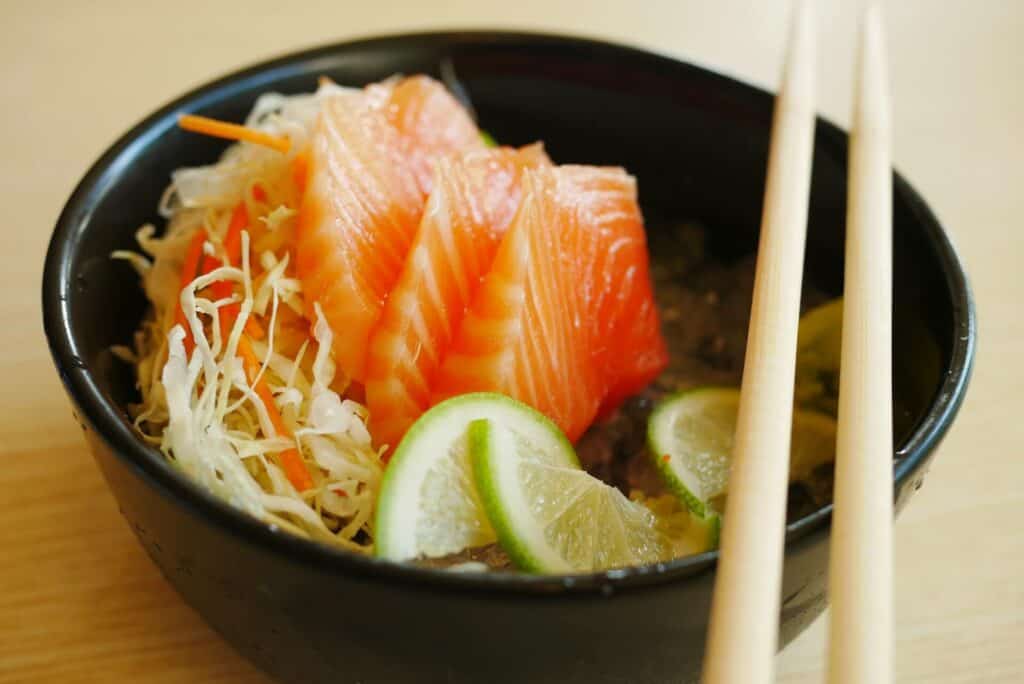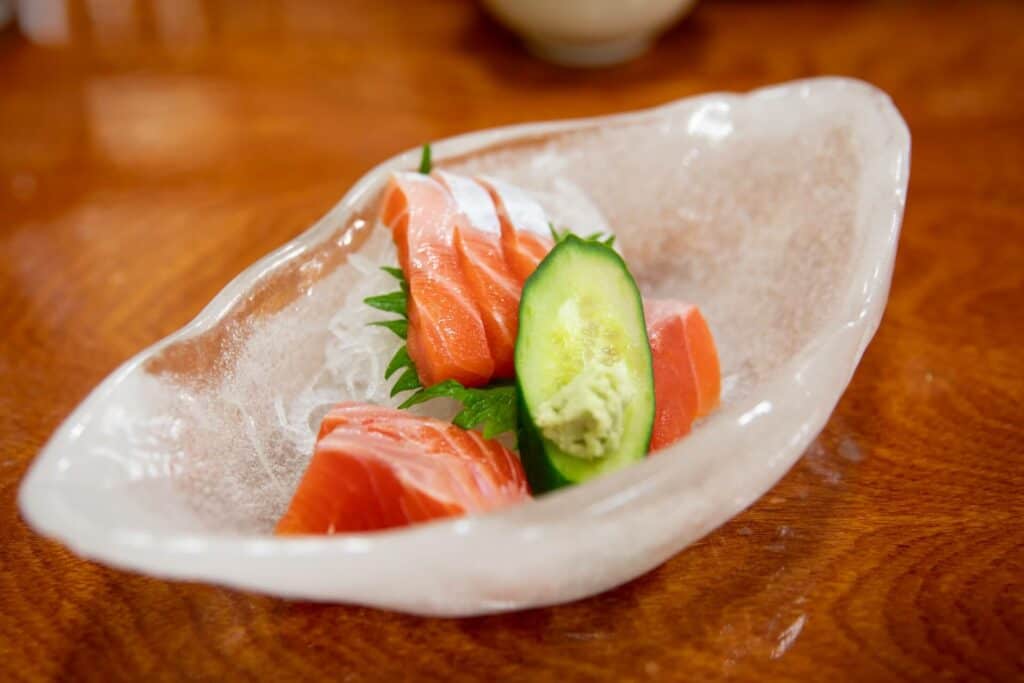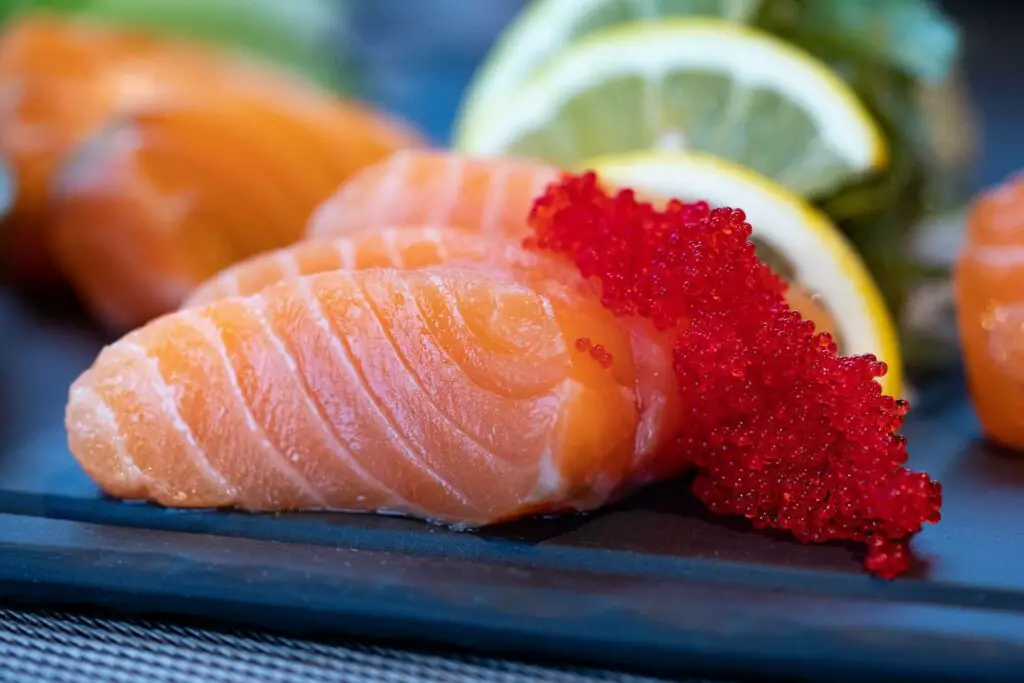Japanese cuisine differs from Western one. There are many dishes Westerners know almost nothing about, including salmon sashimi. So, what is salmon sashimi exactly?
Salmon sashimi is a type of sashimi dish, a delicacy made from thinly sliced raw fish served with sauce, condiments, and garnishes. When prepared right, salmon sashimi tastes exceptional and has numerous health benefits. However, salmon used for this dish must be entirely safe for raw consumption.


The following article can help you learn more about this dish, so you can thoroughly enjoy it the next time you taste it.
Salmon Sashimi Is a Delicacy Made From Raw Salmon
Sashimi is a Japanese dish with thinly sliced raw fish as the primary (almost sole) ingredient. Salmon sashimi, therefore, is a delicacy in which the chosen fish meat is salmon. It must be of the highest quality and completely safe to consume in the raw state.
In fish markets, you can often see salmon labeled sashimi grade. It doesn’t mean that you should use the fish to prepare a sashimi dish, but point out the quality of it. Sashimi or sushi-grade salmon should be top-tier and safe to eat without heat treatment.
The Origin of Salmon Sashimi
Today, salmon is one of the most popular sushi and sashimi ingredients. However, did you know salmon wasn’t a part of Japanese menus until the 1990s? In Japan, Pacific salmon was only consumed cooked, never raw, because of parasites it often carried.
However, with the development of aquaculture and salmon farming, parasites-related risks were significantly lessened. It has resulted in salmon becoming one of the favorite sushi and sashimi ingredients worldwide.
It differentiates itself from other sashimi dishes due to its bright orange color. It is also considered to be fattier than tuna sashimi – even though different pieces can vary from lean to fattier.

How to Eat Salmon Sashimi?
Salmon sashimi can be served as an appetizer or main dish. In the second case, Japanese chefs recommend sashimi to be eaten before dishes with more robust flavors – after all, sashimi is considered one of the finest dishes in Japanese culture.
As opposed to sushi, which has sushi rice and fish as main ingredients, salmon sashimi is usually served without rice. Additionally, while sushi can have numerous accompaniments (seaweed sheets, vegetables, eggs, and the like), sashimi is generally eaten plain, with other (optional) ingredients on the side.
If you’re preparing salmon sashimi yourself, make sure your knife is sharpened. Prepare a stable base for cutting and start slicing. Each piece should have a rectangular form, while the thickness should be adjusted to your flavor.
What Are Other Salmon Sashimi Ingredients?
Thinly sliced salmon is the center of this dish but is commonly served with:
- Dipping sauce – usually soy or ponzu sauce. Ponzu sauce is made with the addition of citruses, so it is suitable for those who enjoy a slightly more tangy flavor. You can also use regular soy sauce, but sprinkle the salmon with lemon juice.
- Condiments – you can use wasabi paste, fresh ginger or garlic (grated), or pickled ginger.
- Garnishes – fish salices should be placed on a garnish. Traditionally garnishes are long strands of Asian white radish or shiso leaves. However, you can use any type of delicate microgreens and lemons to decorate the plate or bowl.
Is Raw Salmon the Same as Sashimi Salmon?
Not any raw salmon can be used for sashimi. It must be sushi or sashimi-grade – treated with extra care and absolutely safe to eat raw. If it has not undergone all the necessary procedures, it can only be consumed cooked.
Is It Safe to Eat Salmon Sashimi?
If salmon has a sushi or sashimi-grade label, it should be safe for consumption. Most salmon today are aquacultured, so the risk of parasites is minimized. However, make sure you eat salmon sashimi in a reputable restaurant or buy sashimi from a trustworthy seller since a sashimi-grade term is more arbitrary than officially regulated.

Is Salmon Sashimi Healthy?
Like many dishes that are part of Japanese cuisine, salmon sashimi is very healthy. Keep in mind that it increases metabolic rate and regulates hormones responsible for appetite control which can help maintain healthy body weight.
Salmon sashimi is rich in important nutrients that can provide numerous health benefits. Take a look at the table below to find out more about them.
| Nutrient | Benefit |
| Protein | Provides energy and promotes muscle growth |
| Omega-3 fatty acids | Good for the body’s overall well-being Promotes cardiovascular health Decreases belly fat |
| Vitamin B | Reduces inflammation Creates energy from food Repairs and creates DNA |
| Potassium | Reduces blood pressure |
| Selenium | Protects bone health Decreases thyroid antibodies Improve blood levels |
Make Sure This Delicious and Light Meal Is a Part of Your Diet
As you can see, salmon sashimi is not only tasty but healthy as well, which makes it the perfect choice for any meal. Implementing it in your diet can provide numerous benefits, as long as you acquire it from a trustworthy source. One thing is certain – once you try it, it will become one of your favorite delicacies.
